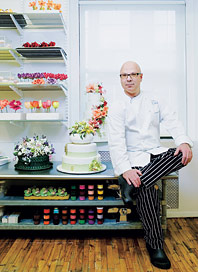
Ron Ben-Israel
People who look at wedding cakes for a living know a Ron Ben-Israel cake when they see one.
Yes, well, my emphasis is on technique. My work is very neat. There are no smudges, no mistakes.
And for this, brides pay a premium.
They pay for originality. They get a cake in June that has been worked on since January, a cake that nobody else will have, one that nobody will have seen at another wedding or in a magazine. We use top-of-the-line equipment, the best butter and eggs, and a crazy food scientist who mixes challenging food colors for us.
Is your topsy-turvy cake which looks as if it’s in mid-topple still in demand?
We get requests at least once a month. Our most recent was for a wedding at the St. Regis: chocolate-iced with gold trim and magenta and chartreuse flowers. It’s for couples who want something unexpected. It’s much more labor-intensive—delivered in pieces and constructed on-site. In general, one of my cakes, for a 200-person wedding, costs $2,600 to $3,000. A topsy-turvy cake costs $5,000.
How do you make such realistic-looking sugar flowers?
To make a sugar orchid, you first need to study the structure of a real one. We cast each part—sepals, petals, tongue, throat—in silicone, roll the shapes of the petals thin, imprint, and cut them. Then we have to shape them and let them dry for 24 hours. After that, we assemble and color each flower, which takes four hours per orchid. It must be timed so they are fresh when placed on the cake.
Do you ever decorate with real flowers?
No, they wilt and can have toxic pesticides. Plus where is the artistry in using real flowers? Where is the aristocracy in that?
What looks modern?
Use one kind of flower. Adorn a whole cake with cattleya orchids, or do one with only pink peonies. Combine tier shapes: a round, then a square, a round, and so on.
How have clients custom-designed their wedding cakes?
One Russian bride wanted to capture the idea of the cherry orchard. (The Cherry Orchard is Anton Chekhov’s last play.) So we designed a five-foot sugar cherry tree growing out of the cake. Hindi brides bring their saris, others bring swatches of gown fabric like lace. We cast it in sugar and apply it to the cake. For months I’ve been working on creating techniques to reproduce Swarovski crystals in sugar using the real stones to guide me.
The cake is served at peak dance hour.
You probably pray for a lousy band. I cannot deal with people who do not eat the cake—clients who want the look but aren’t interested in how it tastes.
What’s delicious?
Pistachio. Passion fruit. Peanut butter with chocolate or flaked coconut with almonds are popular. Once, for a Japanese bride, we did a green-tea cake.
That’s interesting, though maybe not for every palate.
There was a period that I experimented with lemongrass. It just didn’t catch on. You must remember that what people are willing to try in a restaurant doesn’t always work at a wedding.
How does one go about preserving the top tier for the first anniversary?
We provide a box and instructions to follow so it’s as good as the day of the wedding. Some couples have confessed to finding it in the freezer, randomly, and eating it, just like that, because they were hungry in the middle of the night.

TIPS FROM THE TRADE
The groom’s cake is slowly making a comeback. Akin to the slightly patronizing ritual of the bouquet toss, the dessert has its origins in superstition: Unmarried bridesmaids slept with a slice beneath their pillows to summon dreams of their future husbands. For a Swiss groom at his St. Regis wedding, Ben-Israel “made one that looked like a wedge of Swiss cheese” and had the maître d’ wear lederhosen. It’s a confectionery inside joke, so don’t empty your pockets (from $7 per serving at michelledollcakes.com
212-625-3369; weddingcakes.com